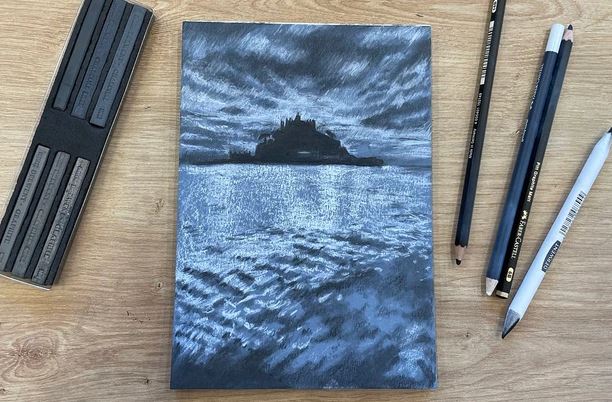Charcoal Drawing For Beginners: How To Make Charcoal Art. Charcoal drawing is a very versatile medium to try out. We can use charcoal to make textured arrangements or mix them with soft tones: charcoal pictures look like photographs!
Using charcoal will teach you to look at your drawings differently. The little colouring palette causes you to concentrate better on light and faint hues, which will help you improve your overall drawing and painting techniques.
Here we start
We can draw almost anything with charcoal, but they are especially popular with portrait and landscape painters. Once you learn rare easy strategies, you’ll be amazed at what you can make.
This medium can stand slightly dirty, but that’s characteristic of the pleasure! Allow yourself to be a little confused and explore the effects that coal can be used to create. If you’re worried about staining your work, you can put a sheet of paper under your hand to keep your writing clean.
A charcoal painting is suitable for artists of all skill levels, and you must purchase a rare textile to begin creating your charcoal craftwork. In this guide, we’re going to show you the charcoal drawing materials that you should buy to create your beautiful charcoal drawings, and we’ll show you some techniques for pencil art to get you started!
How to draw with charcoal
Now that you have all of your charcoal drawing materials, we will direct you to create a beautiful charcoal sketching degree by degree.
You will need:
- Charcoal pencils
- Varieties for mixing paper
- Tailor’s Chalk
- Charcoal sticks
- Coloured paper block
- Gum for mastic or kneading gum
- Fixing spray (optional)
Total time:
An afternoon
Step 1
If you are new to charcoal drawing, I recommend drawing from a photo first. Look for an image with strong contrasts of light and dark, which will help you create a stunning appearance. You can take a picture of anything you want, but I will draw a landscape for this example. I’ll build my design freely on the photo below: It’s St. Michael’s Mount in Cornwall. Feel complimentary to utilise this picture for your strategy!

First, take a black charcoal pencil and lightly outline your picture. It has to be too precise at this point – you’ll add more details later. You can use a plastic eraser (putty rubber) to remove unwanted lines if you go wrong.

Step 2
Then use the graphite pencil to lightly mark some of the darker areas of the image so you can get a concept of which areas need to be shaded. You can also start drawing the shapes of the clouds.

Step 3
Using a dark charcoal pencil, start adding shades to the sky. I like to work in one direction, so the shading lines are diagonal across the sky. However, you can create interesting textures by shading in the opposite direction – experiment and see what works for you! Mix the clouds with the stump a little.
Use a charcoal pencil to add more shadows to the sky. Gradually build up the colour and create gentle nuances with the stump or finger from light to dark. Bumble or vibrate the article to release excess carbon.

Step 4
Next, take a white charcoal pencil and add some highlights to your charcoal drawing. Again, I work diagonally to connect to the black graphite markings. Go over the lid of your white graphite with stitcher’s chalk to add fairer highlights.
I start from the top and work on the drawing, and I don’t use my hand to fade the sketch. Tip: If you tend to spread your photos around, try putting a piece of shredded document underneath your hand.

Step 5
Currently, we’re moving to remove the palace! Use a dark graphite pencil to reach over the design of the lock, then blend it in. I added a little white charcoal pencil to highlight the roof of a building and demonstrate that there exist other constructions on the isle – you accomplished adding all the details about the houses. Add some markings to indicate they are there.
You could walk over the castle with a coal stick if you want to make it darker and even more dramatic!

Step 6
Now I’m going to draw the sea. Typically, when removing a landscape, you want to add more minor details in the distance and more foreground elements. This can create a sense of depth even when there is nothing else in the landscape (or seascape) to understand perspective.
Since I’m using denim blue paper, a lot of the work has already been done for me, so I scraped the entire side of the tailor’s chalk onto the drawing to add instant texture. Please do not go all the way down the page, as we will be adding more details there. Use the intersection of the stitcher’s chalk to emphasise specific sea areas. For example, I added a little highlight to the right side of the island to make it stand out.

Step 7
Now we deal with the foreground of the drawing. Using black charcoal pencils, add some waves to the image. Draw lightly, then use a charcoal pencil to create the colours. Blend the lines lightly with the blending stump.
Add some darker tones to the lower part of the design to show off the sea’s dark depths. Use some charcoal pencils and blend with the paper stump.

Step 8
Now put some highlights in the water with white graphite. You may want to brush over them one more time with the stitcher’s chalk to add additional light areas and massage it over the base of the article for a shimmery look.

Step 9
Now is the time to review the drawing and add the finishing touches. Look at your photo and compare it to the original image. Are there areas that need to be darker? Do you need to add more highlights everywhere? This is a great moment to wash up any sections of the drawing you are unhappy with and make your photo look the best it can.
Finally, I went back to the waves and added more anthracite white highlights as they would be a little smeared. This is an excellent thing when you finish your drawing, and you are sure that you are not adding any more charcoal.

Resume until you are satisfied with your layout, then cover it with a light layer of setting spray.
Also read: WHAT IS UDYAM REGISTRATION



More Stories
VMware 1V0-21.20 Exam Dumps – Trick To Passing In First Attempt
Greatest Nutanix NCM-MCI-5.15 Exam Dumps With Success Ensure [2023]
Excellent Advantages to Choose UK to Study MBA in UK